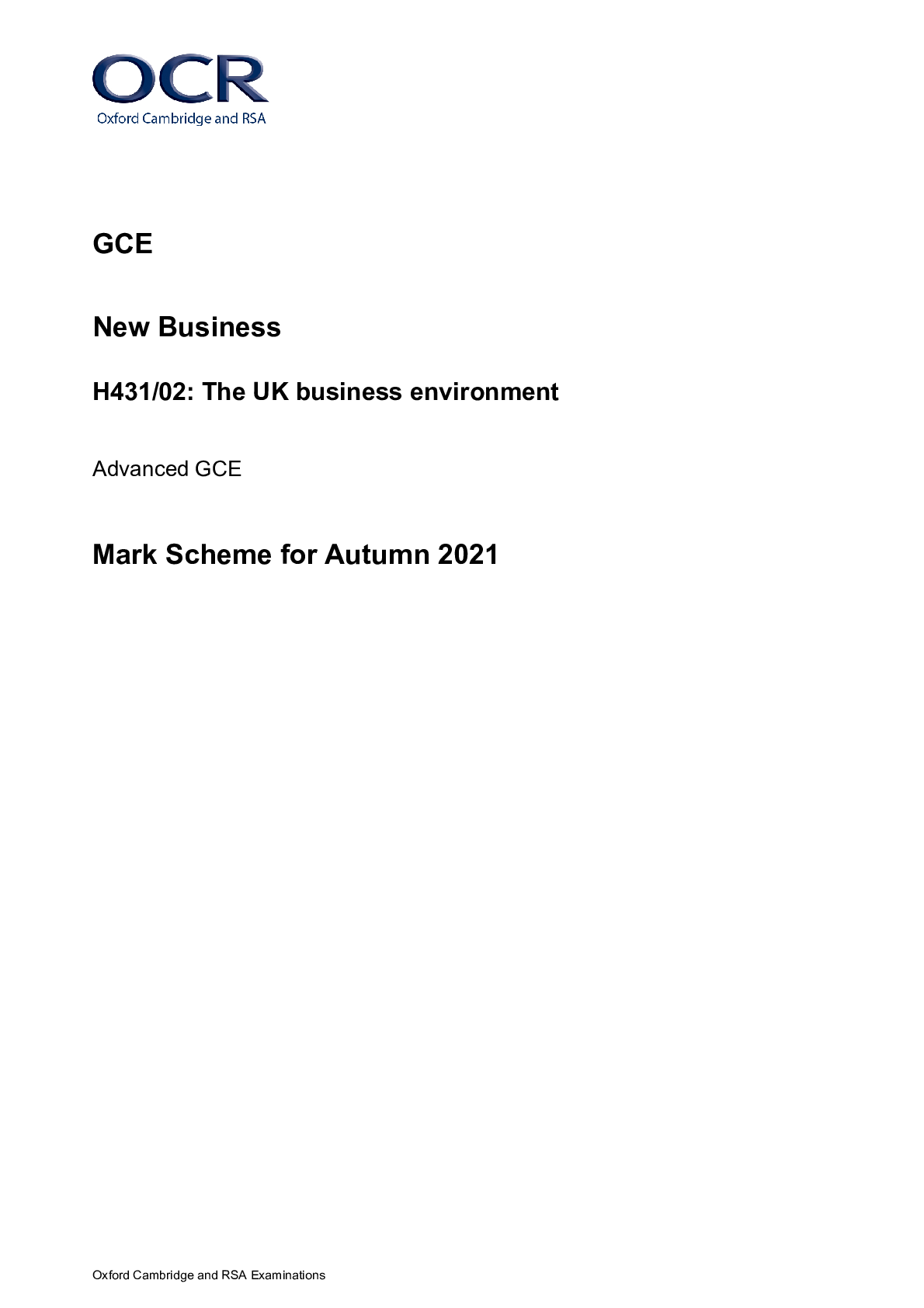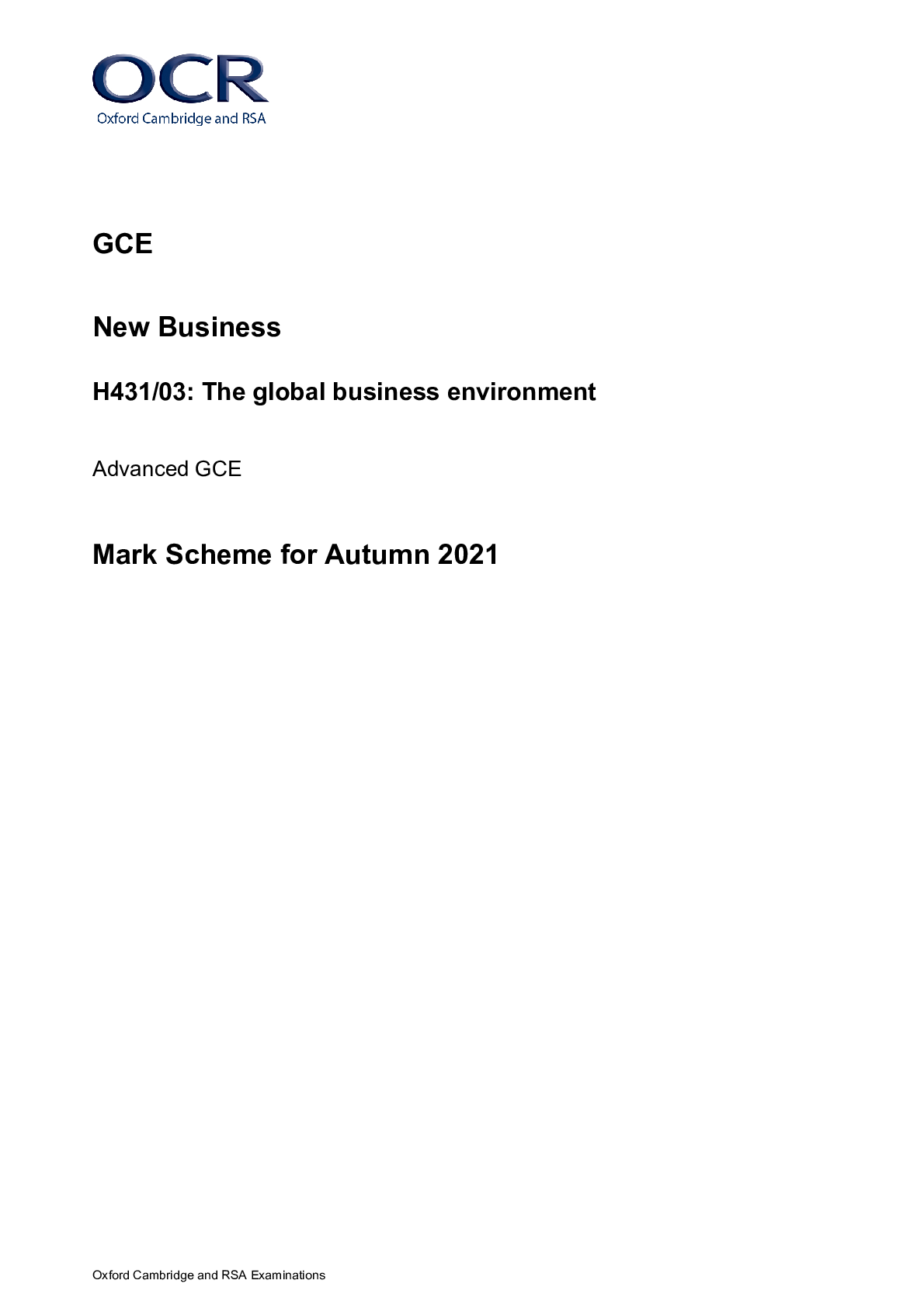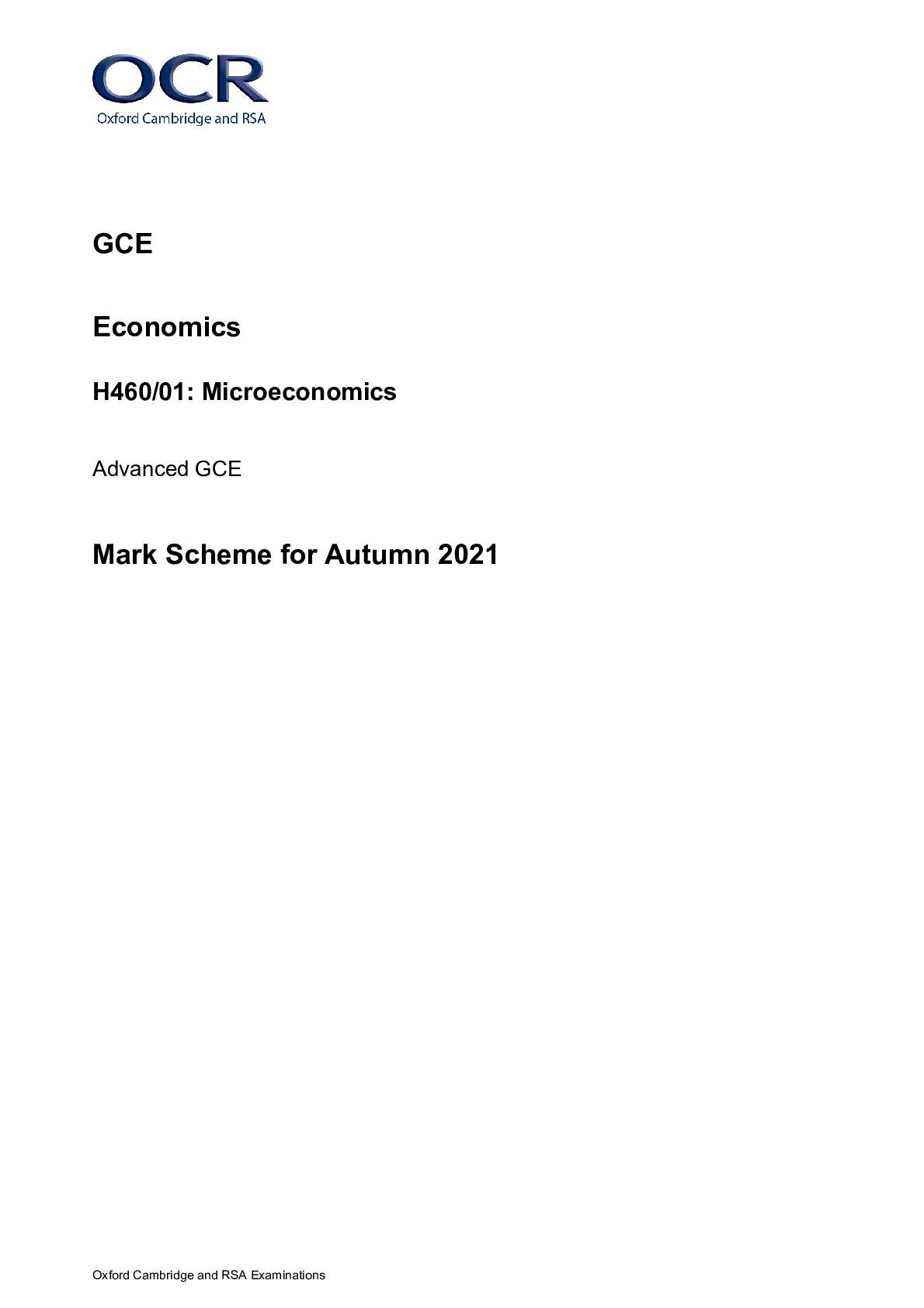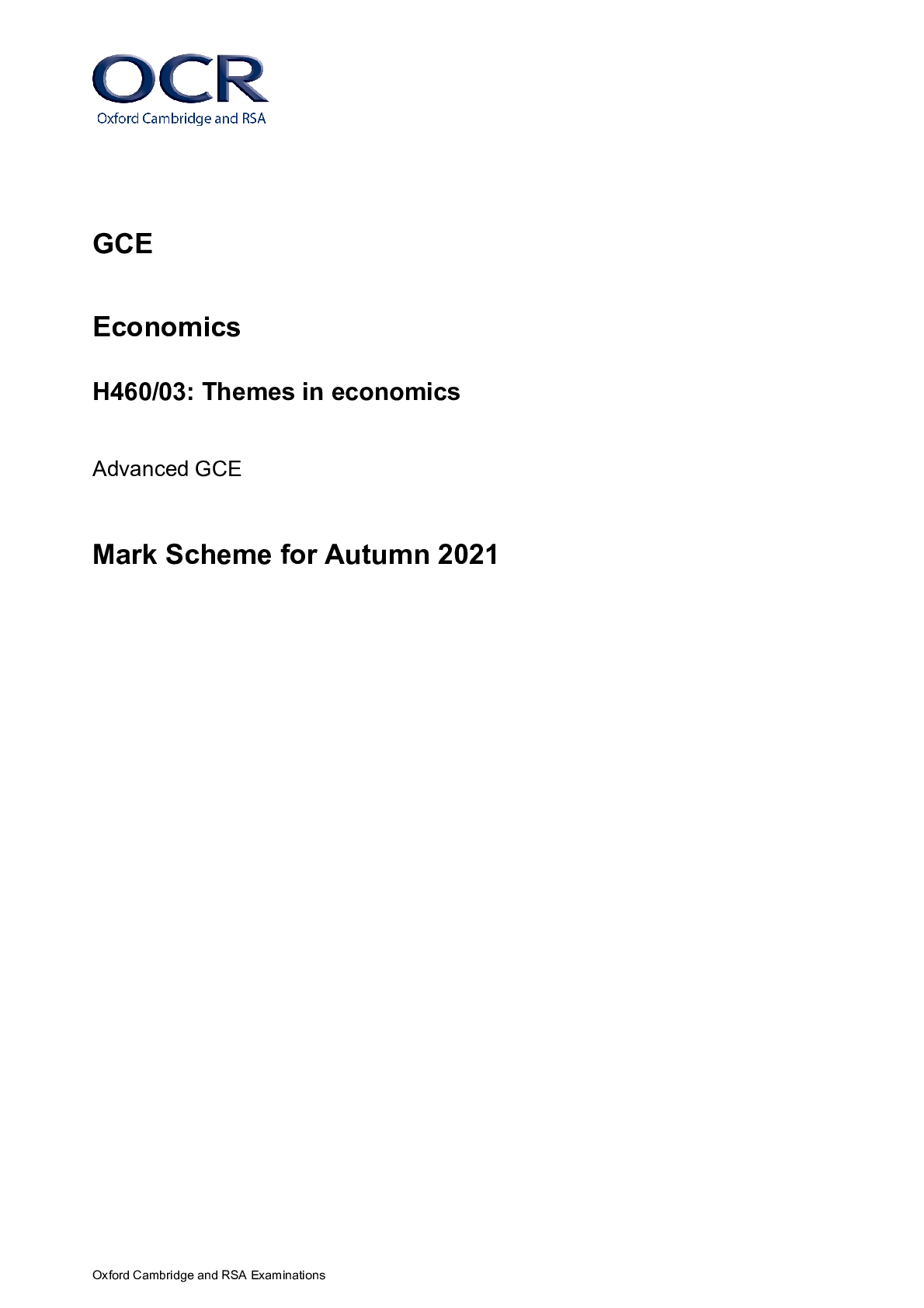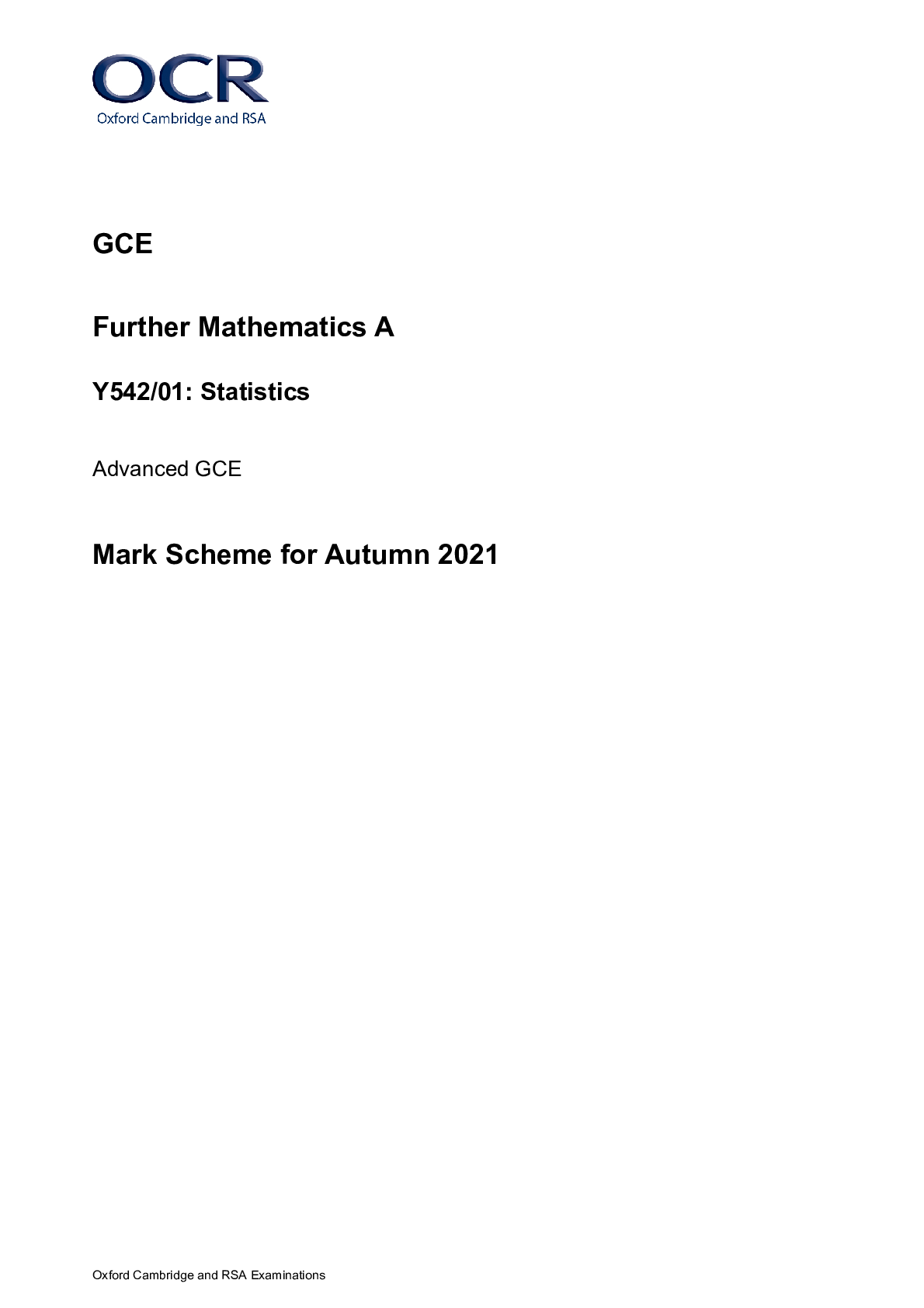Religious Studies > MARK SCHEME > GCE Religious Studies H573/06: Developments in Buddhist thought Advanced GCE Mark Scheme for Novembe (All)
GCE Religious Studies H573/06: Developments in Buddhist thought Advanced GCE Mark Scheme for November 2020
Document Content and Description Below
GCE Religious Studies H573/06: Developments in Buddhist thought Advanced GCE Mark Scheme for November 2020 Oxford Cambridge and RSA Examinations GCE Religious Studies H573/06: Developments... in Buddhist thought Advanced GCE Mark Scheme for November 2020Oxford Cambridge and RSA Examinations OCR (Oxford Cambridge and RSA) is a leading UK awarding body, providing a wide range of qualifications to meet the needs of candidates of all ages and abilities. OCR qualifications include AS/A Levels, Diplomas, GCSEs, Cambridge Nationals, Cambridge Technicals, Functional Skills, Key Skills, Entry Level qualifications, NVQs and vocational qualifications in areas such as IT, business, languages, teaching/training, administration and secretarial skills. It is also responsible for developing new specifications to meet national requirements and the needs of students and teachers. OCR is a not-for-profit organisation; any surplus made is invested back into the establishment to help towards the development of qualifications and support, which keep pace with the changing needs of today’s society. This mark scheme is published as an aid to teachers and students, to indicate the requirements of the examination. It shows the basis on which marks were awarded by examiners. It does not indicate the details of the discussions which took place at an examiners’ meeting before marking commenced. All examiners are instructed that alternative correct answers and unexpected approaches in candidates’ scripts must be given marks that fairly reflect the relevant knowledge and skills demonstrated. Mark schemes should be read in conjunction with the published question papers and the report on the examination. © OCR 20202 Indicative content – Responses might include: Guidance 1. ‘Pure Land Buddhism is not an easy path.’ Discuss AO1 Candidates may demonstrate knowledge and understanding through the use of some of the following ideas: • Pure Land Buddhists follow the teachings found in the Lotus Sutra, which suggests that this is a degenerate age where the world has been overcome by greed, hatred and ignorance and therefore achieving enlightenment is currently impossible. • Pure Land Buddhists look to be reborn in the Pure Land in order to achieve enlightenment, because it is not possible to do so from the world as it is at the moment. • Pure Land Buddhists chant and this will enable them to be reborn in the Pure Land. • the arhat path by comparison may stretch over more than three lives and involve strict monastic discipline. Therefore, some have suggested that by comparison Pure Land Buddhism is an ‘easy’ path. AO2 Candidates may demonstrate evaluation and analysis through the use of some of the following arguments. • Some candidates might argue that Pure Land Buddhism is not an easy path because: o Pure Land Buddhists believe that there are more distractions that would inhibit a person’s progress to enlightenment in the modern age and therefore, focusing on Amitabha Buddha is not ‘easy’ o the Pure Land Buddhist chant is repeated constantly whilst going about a person’s daily routine. However, being constantly mindful of this chant is not easy o Pure Land Buddhism still requires that same commitment to renunciation and moral conduct as every other form of Buddhism, so it is no easier than others o once a person has been re-born in the Pure Land they still have to learn and practise in the same way that monks or nuns might and therefore they will have to undergo the same disciplines outlined by the Buddha. Therefore, they have not avoided this ‘difficult’ path. • Some candidates might argue that Pure Land Buddhism is an easy path because: o the Pure Land Buddhist chant is the only appropriate thought when one considers the actions of Amitabha Buddha o Pure Land Buddhism focuses more on devotional practice than meditation, and has more lenient rules (for example killing fish is not seen as an unskilful action), which makes it more accessible to all Buddhists, particularly those who cannot access philosophical teachings o the Pure Land is made specifically to be conducive to gaining3 Indicative content – Responses might include: Guidance enlightenment. Therefore, it is easier than trying to gain enlightenment in the degenerate world as it is o Amitabha Buddha has vowed to save all beings and therefore this makes it easier to gain enlightenment • Some candidates may combine these views and argue that: o Pure Land Buddhism recognises that it is difficult in the modern world to meditate for long periods or to become a monk/ nun and therefore their teachings are a short cut (easy path) to a more ‘enlightenment-friendly’ world o some might argue that it has and will always be difficult to focus the mind because the three fires/poisons are always present in the human mind and they are the main barrier to enlightenment. Therefore, there is no easy path.4 Indicative content – Responses might include: Guidance 2. ‘The Buddha would not agree with the teachings of Nagarjuna’s Madhyamaka (middle way) philosophy.’ Discuss. AO1 Candidates may demonstrate knowledge and understanding through the use of some of the following ideas: • Nagarjuna founded the Madhyamaka (middle way) school in the first century CE • he focused on the teachings in the Heart Sutra • this taught that all things are empty of inherent existence (sunyata) because they are dependently co-arisen • Nagarjuna also taught that there are two truths: conventional and ultimate • these teachings are seen by some as a departure from the teachings of the historical Buddha namely the Four Noble Truths and Eightfold Path. AO2 Candidates may demonstrate evaluation and analysis through the use of some of the following arguments. • Some candidates might argue that the historical Buddha would not agree with the teachings of Madhyamaka (middle way) philosophy because: o Some Theravada Buddhist texts suggest that all things exist as separate items or have own existence (svabhava) and can be categorised. Therefore, the Buddha would probably disagree with Nagarjuna’s rejection of svabhava (own being) o the historical Buddha may not have agreed with the concept of two truths. the Buddha taught using skilful means (upaya) therefore truth was relative to the ability of those who were being taught o the Heart Sutra is not recognised by some as a teaching of the historical Buddha. It is a teaching by the Bodhisattva Avalokiteshvara (and endorsed by the Buddha) o Nagarjuna seems to focus more on awakening the human’s Buddha nature rather than the morality, wisdom and contemplation taught by the historical Buddha. • Some candidates might argue that the historical Buddha would agree with the teachings of Madhyamaka (middle way) philosophy because: o the historical Buddha taught that all phenomena are interlinked and that they dependently originate. This would support Nagarjuna’s teaching on sunyata (emptiness) o all things exist because of all other things that exist. ‘This being, that exists; through the arising of this that arises. This not being, that does not exist; through the ceasing of this that ceases.’ (MN79) o it is believed that Nagarjuna received these teachings from5 Indicative content – Responses might include: Guidance spirits, who had been taught them by the historical Buddha, and kept them safe until such time as someone could understand them o there is much debate over the Theravada teachings, with many arguing that it teaches that dhammas can be categorised by their characteristics but this does not mean that dhammas have own being. Therefore, there are no differences between these teachings and Nagarjuna’s. • Some candidates may combine these views and argue that: o Madhyamaka (middle way) philosophy is a development of the historical Buddha’s teachings so it is consistent with but not the same as the original teachings.6 Indicative content – Responses might include: Guidance 3. To what extent could a Buddhist ever accept the need for war? AO1 Candidates may demonstrate knowledge and understanding through the use of some of the following ideas: • Buddhism has always seen itself as a religion of peace and this is promoted by the Buddha throughout his teaching career • Buddhist countries engaged in warfare but it is difficult to find any Buddhist rationale for the use of war • Buddhism has a wide range of resources used to dissolve conflicts • hatred is one of the three fires/poisons • ‘greater in battle, than the man who would conquer a thousandthousand men, is he who would conquer just one — himself.’ (Dhammapada 103) • ‘overcome the angry by non-anger’ (Dhammapada 223). AO2 Candidates may demonstrate evaluation and analysis through the use of some of the following arguments. • Some candidates might argue that it is possible to accept the need for war because: o although the Buddha always taught that violence was never the skilful response and that monks and nuns should never use violence, it has sometimes been necessary for lay Buddhists to use violence in times of war. o a war can be fought in defence of family/ country/ religion because the intention is not to kill but to save lives o candidates might illustrate their arguments using examples they have studied. Some examples that might be considered include the following: o in Thailand national service is required from all men except those who are long term monks. Former monks are often employed as army chaplains o in Sri Lanka the Buddhist monasteries supported the government’s fight against the invading Tamil people, the earliest example of this being in 90 BCE. o in Myanmar the 969 movement is led by Buddhist monks. They promote anti-Islamic attitudes and have been reported as suggesting that killing a Muslim is a kindness so that they stand a chance of being reborn as a Buddhist. • Some candidates might argue that it is impossible to accept the need for war because: o in the Eightfold Path, right livelihood forbids a Buddhist from handling weapons o the Dhammapada states ‘Greater in battle, than the man who would conquer a thousand-thousand men, is he who would7 Indicative content – Responses might include: Guidance conquer just one — himself’ (Dhammapada 103) and ‘Overcome the angry by non-anger’ (Dhammapada 223) o the three fires/poisons include hatred, which causes suffering, therefore overcoming hatred is essential for enlightenment. o the Buddha taught that conflict arose from attachment and greed or from material deprivation o propaganda used in war times is seen as an example of wrong speech. • Some candidates may combine these views and argue that: o the Buddha failed on several occasions to give his view on the morality of soldiers, but he did make it clear that any soldier shares the guilt of killing even if they have not themselves killed o lay Buddhists have put aside the First Precept in order to defend themselves and this has been seen to be morally acceptable but still generating negative kamma.8 Indicative content – Responses might include: Guidance 4. Assess the claim that the is sangha the most important part of modern Buddhism. AO1 Candidates may demonstrate knowledge and understanding through the use of some of the following ideas: • the sangha is one the Three Refuges, the other two being the Buddha and the dhamma • the sangha was established by the Buddha • the sangha can refer to the monastic community of monks and nuns or it could refer to the whole of the Buddhist society which includes the monks and nuns and the lay men and women • the fourfold sangha is the basis of a Buddhist society • the sangha is the repository of the teachings of the Buddha. It is responsible for keeping them alive and passing them on to the next generation. • the sangha generates good kamma and passes this on to the local community AO2 Candidates may demonstrate evaluation and analysis through the use of some of the following arguments. • Some candidates might argue that the sangha is the most important part of modern Buddhism because: o it keeps the teachings of the historical Buddha and passes them on to the next generation, therefore keeping Buddhism alive o the sangha interprets the Buddha’s many teachings and explains these to others so that they can make progress towards enlightenment. This is especially important so long after the Buddha has passed away o the sangha has a social role in providing for the local communities’ moral, spiritual and religious education and wellbeing. o this has become an important function today with the sangha providing education, healthcare, community organisation and leadership and environmental awareness o The sangha has psychological value in its ability to bind society together and provide support for all people • Some candidates might argue that the sangha is not the most important part of modern Buddhism because: o the sangha would not exist without the historical Buddha who established it to begin with and it is him that people look to o without the dhamma the sangha would not have anything to keep and pass on to others. Today this has been published in many languages and uploaded to the internet so that everyone has access to it. It can be argued that this has replaced the need for the sangha o in many countries there is no longer a functioning sangha but Buddhism still exists and flourishes o Mahayana Buddhism developed without the same monastic9 Indicative content – Responses might include: Guidance structure as Theravada Buddhism but this did not hinder its development. Western Buddhism is flourishing without a sangha. • Some candidates may combine these views and argue that: o the sangha has played a fundamental role in the development and spread of Buddhism but part of that role has now been replaced by the publication of the dhamma and commentaries o it can be argued that in countries such as the UK the collection of translated text has become the sangha.1 Level (Mark) Levels of Response for A Level Religious Studies: Assessment Objective 1 (AO1) Demonstrate knowledge and understanding of religion and belief, including: • Religious, philosophical and/or ethical thought and teaching • Approaches to the study of religion and belief Note: The descriptors below must be considered in the context of all listed strands of Assessment Objectives 1 (AO1) and the indicative content in the mark scheme. 6 (14–16) An excellent demonstration of knowledge and understanding in response to the question: • fully comprehends the demands of, and focusses on, the question throughout • excellent selection of relevant material which is skillfully used • accurate and highly detailed knowledge which demonstrates deep understanding through a complex and nuanced approach to the material used • thorough, accurate and precise use of technical terms and vocabulary in context • extensive range of scholarly views, academic approaches, and/or sources of wisdom and authority are used to demonstrate knowledge and understanding 5 (11–13) A very good demonstration of knowledge and understanding in response to the question : • focuses on the precise question throughout • very good selection of relevant material which is used appropriately • accurate, and detailed knowledge which demonstrates very good understanding through either the breadth or depth of material used • accurate and appropriate use of technical terms and subject vocabulary. • a very good range of scholarly views, academic approaches, and/or sources of wisdom and authority are used to demonstrate knowledge and understanding 4 (8–10) A good demonstration of knowledge and understanding in response to the question: • addresses the question well • good selection of relevant material, used appropriately on the whole • mostly accurate knowledge which demonstrates good understanding of the material used, which should have reasonable amounts of depth or breadth • mostly accurate and appropriate use of technical terms and subject vocabulary. • a good range of scholarly views, academic approaches, and/or sources of wisdom and authority are used to demonstrate knowledge and understanding 3 (5–7) A satisfactory demonstration of knowledge and understanding in response to the question: • generally addresses the question • mostly sound selection of mostly relevant material • some accurate knowledge which demonstrates sound understanding through the material used, which might however be lacking in depth or breadth • generally appropriate use of technical terms and subject vocabulary. • A satisfactory range of scholarly views, academic approaches, and/or sources of wisdom and authority are used to demonstrate knowledge and understanding with only partial success 2 (3–4) A basic demonstration of knowledge and understanding in response to the question: • might address the general topic rather than the question directly • limited selection of partially relevant material • some accurate, but limited, knowledge which demonstrates partial understanding • some accurate, but limited, use of technical terms and appropriate subject vocabulary. • a limited range of scholarly views, academic approaches, and/or sources of wisdom and authority are used to demonstrate knowledge and understanding with little success 1 (1–2) A weak demonstration of knowledge and understanding in response to the question: • almost completely ignores the question • very little relevant material selected • knowledge very limited, demonstrating little understanding • very little use of technical terms or subject vocabulary. • very little or no use of scholarly views, academic approaches and/or sources of wisdom and authority to demonstrate knowledge and understanding 0 (0) No creditworthy response2 Level (Mark) Levels of Response for A Level Religious Studies: Assessment Objective 2 (AO2) Analyse and evaluate aspects of, and approaches to, religion and belief, including their significance, influence and study Note: The descriptors below must be considered in the context of all elements of Assessment Objective 2 (AO2) and the indicative content in the mark scheme. 6 (21–24) An excellent demonstration of analysis and evaluation in response to the question: • excellent, clear and successful argument • confident and insightful critical analysis and detailed evaluation of the issue • views skillfully and clearly stated, coherently developed and justified • answers the question set precisely throughout • thorough, accurate and precise use of technical terms and vocabulary in context • extensive range of scholarly views, academic approaches and sources of wisdom and authority used to support analysis and evaluation Assessment of Extended Response: There is an excellent line of reasoning, well-developed and sustained, which is coherent, relevant and logically structured. 5 (17–20) A very good demonstration of analysis and evaluation in response to the question: • clear argument which is mostly successful • successful and clear analysis and evaluation • views very well stated, coherently developed and justified • answers the question set competently • accurate and appropriate use of technical terms and subject vocabulary. • a very good range of scholarly views, academic approaches and sources of wisdom and authority used to support analysis and evaluation Assessment of Extended Response: There is a well–developed and sustained line of reasoning which is coherent, relevant and logically structured. 4 (13–16) A good demonstration of analysis and evaluation in response to the question: • argument is generally successful and clear • generally successful analysis and evaluation • views well stated, with some development and justification • answers the question set well • mostly accurate and appropriate use of technical terms and subject vocabulary. • a good range of scholarly views, academic approaches and sources of wisdom and authority are used to support analysis and evaluation Assessment of Extended Response: There is a well–developed line of reasoning which is clear, relevant and logically structured 3 (9–12) A satisfactory demonstration of analysis and/evaluation in response to the question: • some successful argument • partially successful analysis and evaluation • views asserted but often not fully justified • mostly answers the set question • generally appropriate use of technical terms and subject vocabulary. • a satisfactory range of scholarly views, academic approaches and sources of wisdom and authority are used to support analysis and evaluation with only partial success Assessment of Extended Response: There is a line of reasoning presented which is mostly relevant and which has some structure. 2 (5–8) A basic demonstration of analysis and evaluation in response to the question: • some argument attempted, not always successful • little successful analysis and evaluation • views asserted but with little justification • only partially answers the question • some accurate, but limited, use of technical terms and appropriate subject vocabulary. • a limited range of scholarly views, academic approaches and sources of wisdom and authority to support analysis and evaluation with little success Assessment of Extended Response: There is a line of reasoning which has some relevance and which is presented with limited structure. 1 (1–4) A weak demonstration of analysis and evaluation in response to the question: • very little argument attempted • very little successful analysis and evaluation • views asserted with very little justification • unsuccessful in answering the question3 • very little use of technical terms or subject vocabulary. • very little or no use of scholarly views, academic approaches and sources of wisdom and authority to support analysis and evaluation Assessment of Extended Response: The information is communicated in a basic/unstructured way. 0 (0) No creditworthy response1 Annotations Annotation Meaning Level one – to be used at the end of each part of the response in the margin. Level two – to be used at the end of each part of the response in the margin. Level three – to be used at the end of each part of the response in the margin. Level four – to be used at the end of each part of the response in the margin. Level five – to be used at the end of each part of the response in the margin. (H573 only) Level six - to be used at the end of each part of the response in the margin. Highlighting a section of the response that is irrelevant to the awarding of the mark. Point has been seen and noted, e.g. where part of an answer is at the end of the script. SUBJECT–SPECIFIC MARKING INSTRUCTIONS H173, H573 AS and A Level Religious Studies Introduction Your first task as an Examiner is to become thoroughly familiar with the material on which the examination depends. You should ensure that you have copies of these materials: • the specification, especially the assessment objectives • the question paper and its rubrics • the mark scheme. Please ask for help or guidance whenever you need it. Your first point of contact is your Team Leader. Information and instructions for examiners The practice scripts provide you with examples of the standard of each band. The marks awarded for these scripts will have been agreed by the Lead Marker and Team Leaders.2 The specific task-related indicative content for each question will help you to understand how the band descriptors may be applied. However, this indicative content does not constitute the mark scheme: it is material that candidates might use, grouped according to each assessment objective tested by the question. It is hoped that candidates will respond to questions in a variety of ways. Rigid demands for ‘what must be a good answer’ would lead to a distorted assessment. Candidates’ answers must be relevant to the question. Beware of prepared answers that do not show the candidate’s thought and which have not been adapted to the thrust of the question. Beware also of answers where candidates attempt to reproduce interpretations and concepts that they have been taught but have only partially understood. Using the Mark Scheme Please study the Mark Scheme carefully. The Mark Scheme is an integral part of the process that begins with the setting of the question paper and ends with the awarding of grades. Question papers and Mark Schemes are developed in association with each other so that issues of differentiation and positive achievement can be addressed from the very start. This Mark Scheme is a working document; it is not exhaustive; it does not provide ‘correct’ answers. The Mark Scheme can only provide ‘best guesses’ about how the question will work out, and it is subject to revision after we have looked at a wide range of scripts. Please read carefully all the scripts in your allocation and make every effort to look positively for achievement throughout the ability range. Always be prepared to use the full range of marks. The Mark Scheme contains a description of possible/content only; all legitimate answers and approaches must be credited appropriately. Learners are expected to make use of scholarly views, academic approaches and sources of wisdom and authority to support their argument. The Levels of Response must be used in conjunction with the outlined indicative content. Assessment Objectives Two Assessment Objectives are being assessed in all questions: AO1 (Demonstrate knowledge and understanding of religion and belief) and AO2 (Analyse and evaluate aspects of, and approaches to, religion and belief, including their significance, influence and study). Responses are credited for AO1 for selection, detail and accuracy of the knowledge and understanding of religion and belief deployed. Responses are credited for AO2 for how well the response addresses the question, for candidates using their knowledge and understanding to draw, express and support conclusions in relation to the question posed. Candidates will be assessed on the quality of the conclusions and points they argue and the clarity and success of their argument. Levels of Response Questions in this paper are marked using a levels of response grid. When using this grid examiners must use a best fit approach. Where there are both strengths and weaknesses in a particular response or particularly imbalanced responses in terms of the assessment objectives, examiners must carefully consider which level is the best fit for the performance. Note that candidates can achieve different levels in each assessment objective, for example a Level 3 for AO1, and a Level 2 for AO2.3 Please note that the Assessment Objectives being assessed are listed at the top of the mark scheme. Where a candidate does not address all of the Assessment Objective strands listed, the candidate cannot achieve the top level of response. Assessment of Extended Response The GCE General Conditions of Recognition state that: GCE 5.1 In designing and setting the assessments for a GCE qualification which it makes available, or proposes to make available, and awarding organization must ensure that, taken together, those assessments include questions or tasks which allow Learners to - a) provide extended responses As such, the quality of extended responses are assessed in all questions. While marks are not specifically given for this, descriptors for extended responses can be found in the AO2 Levels of Response in italics.OCR (Oxford Cambridge and RSA Examinations) The Triangle Building Shaftesbury Road Cambridge CB2 8EA [Show More]
Last updated: 1 year ago
Preview 1 out of 17 pages
Instant download

Buy this document to get the full access instantly
Instant Download Access after purchase
Add to cartInstant download
Reviews( 0 )
Document information
Connected school, study & course
About the document
Uploaded On
Oct 07, 2022
Number of pages
17
Written in
Additional information
This document has been written for:
Uploaded
Oct 07, 2022
Downloads
0
Views
38


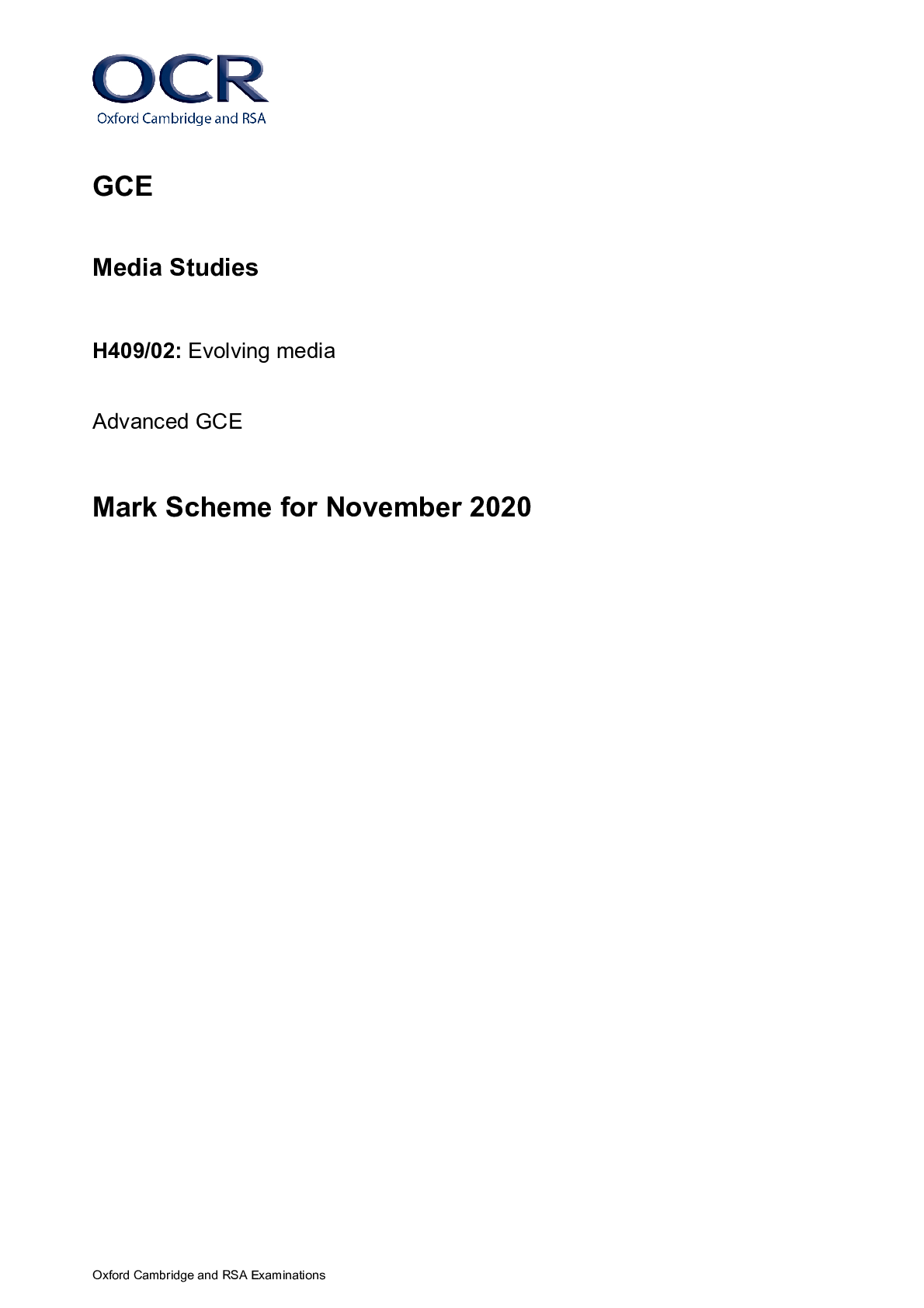
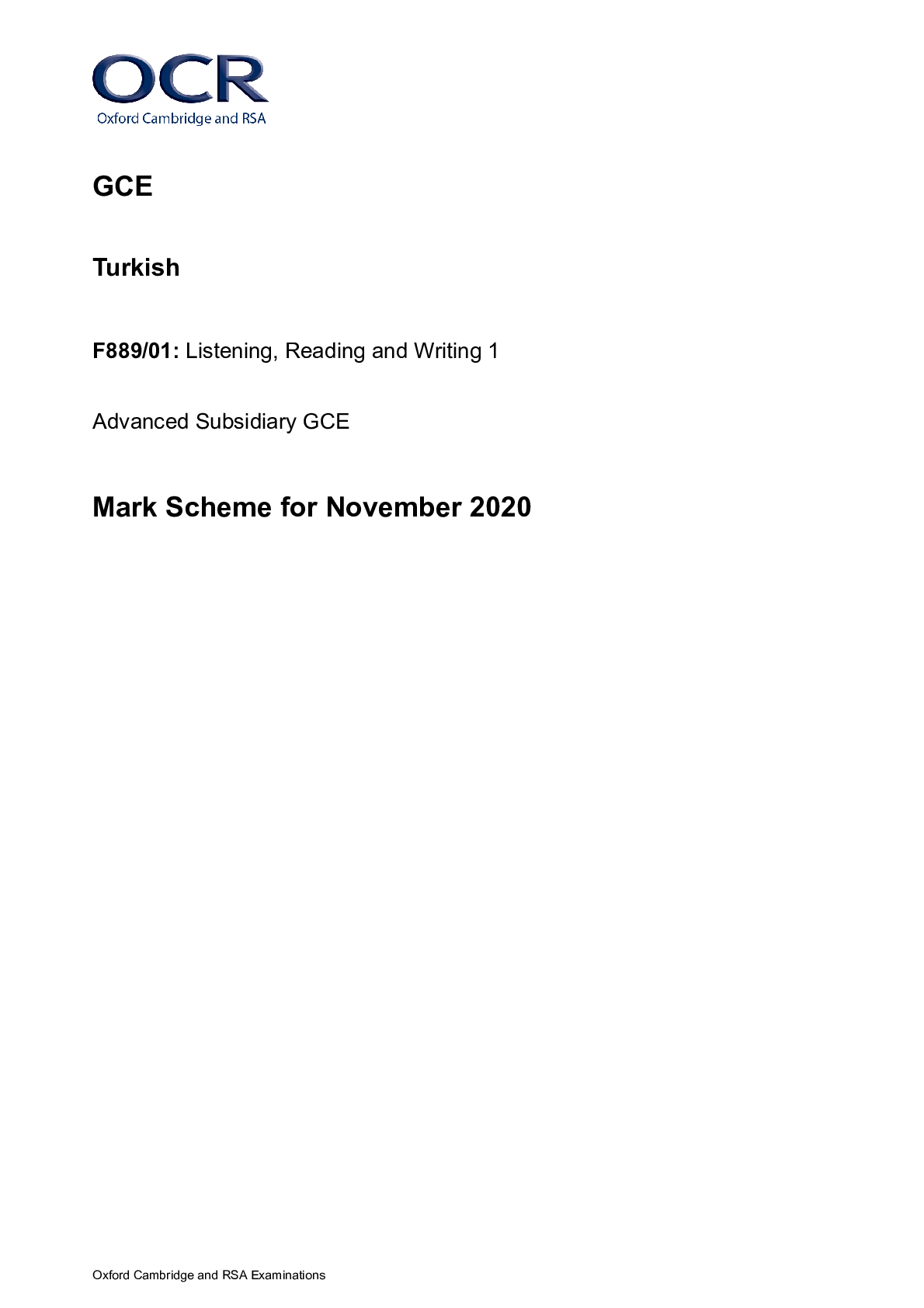
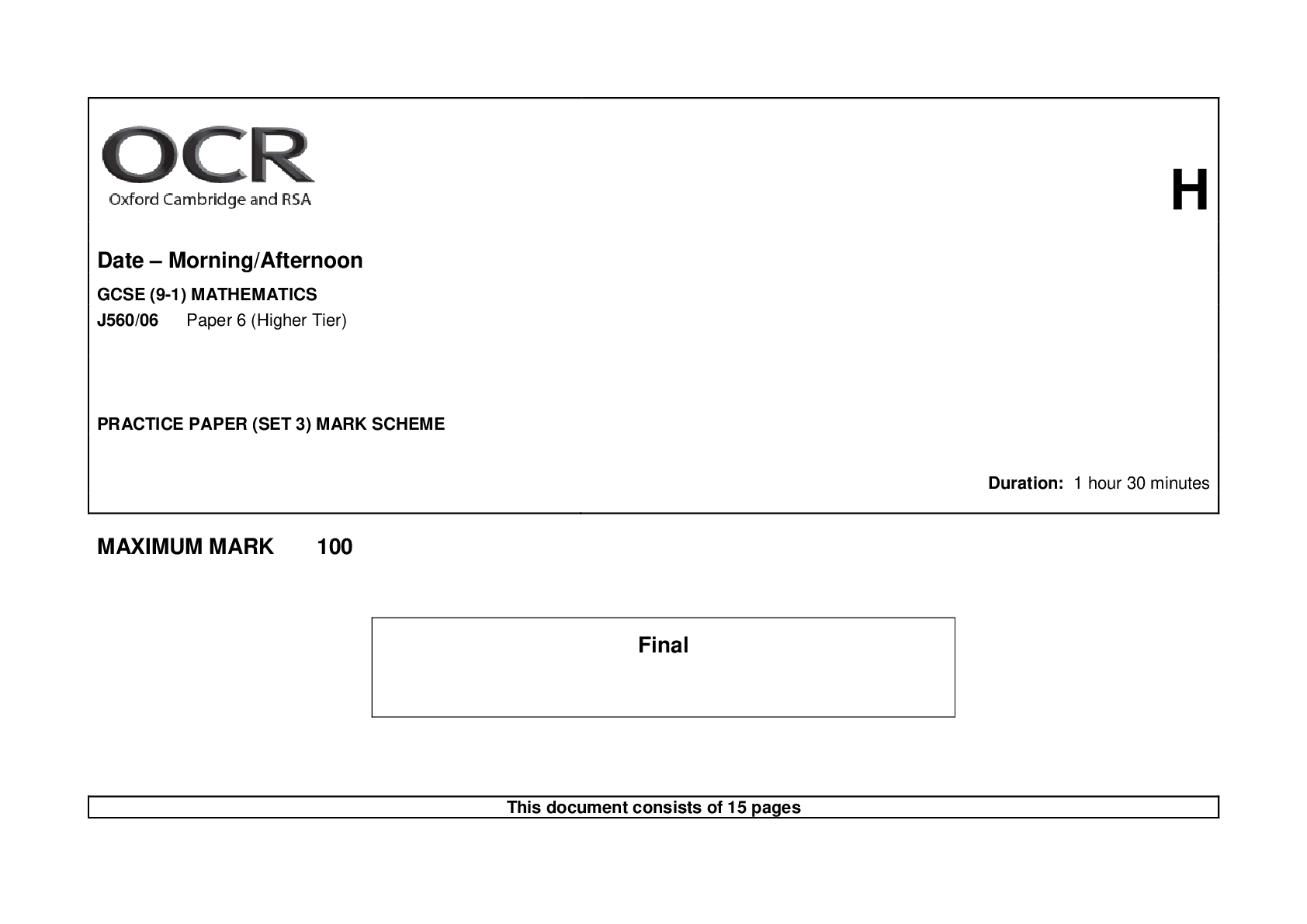


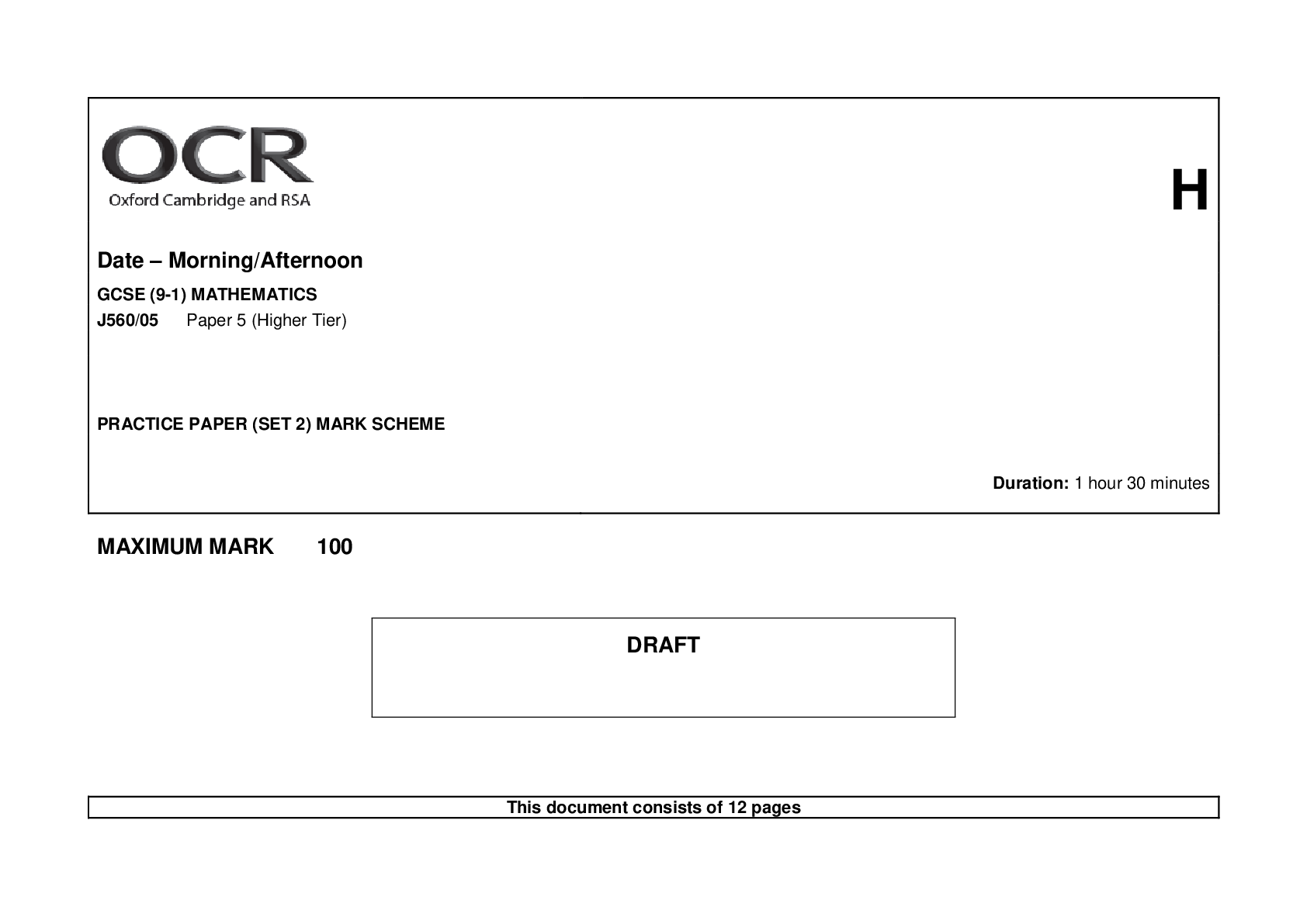
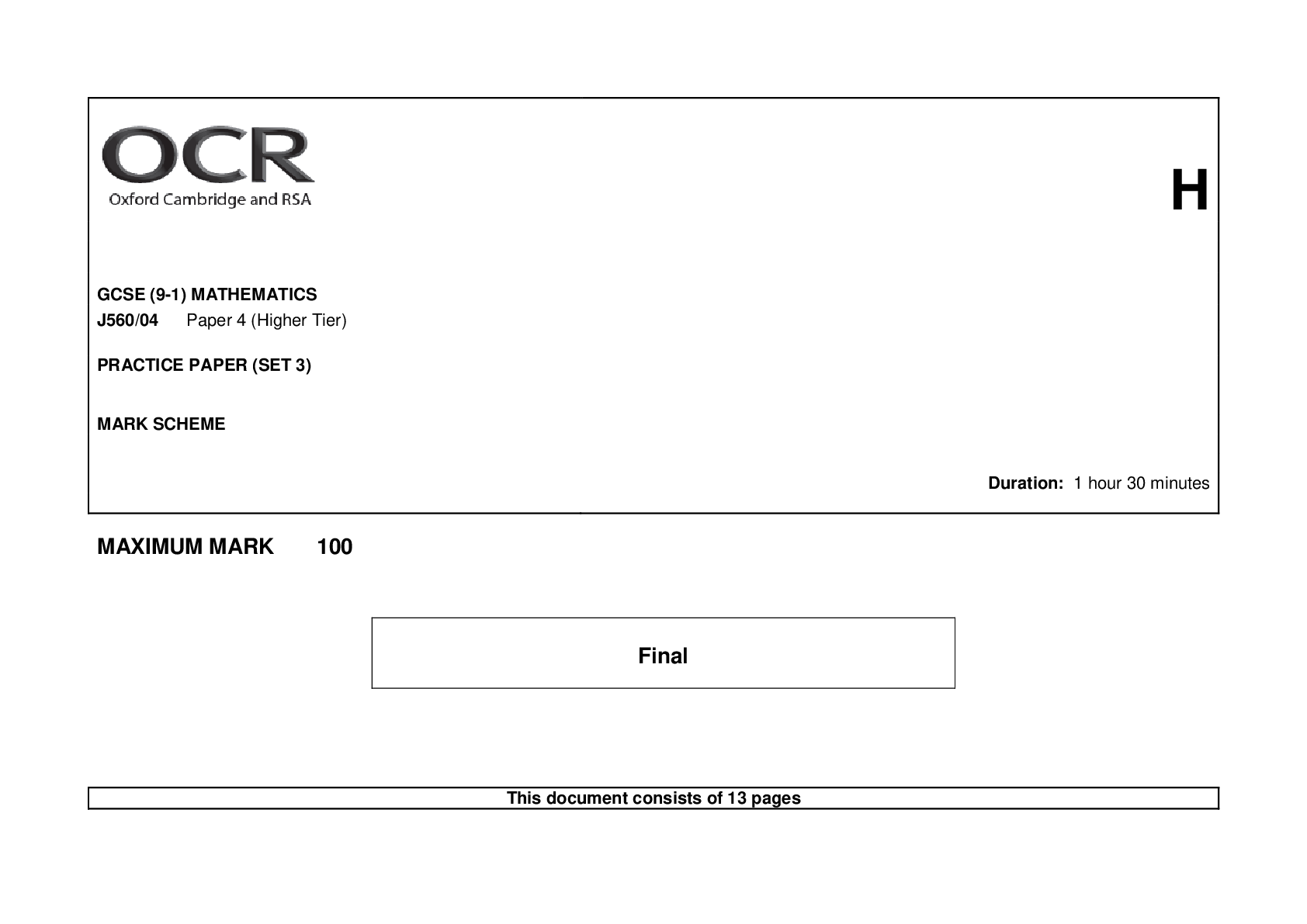
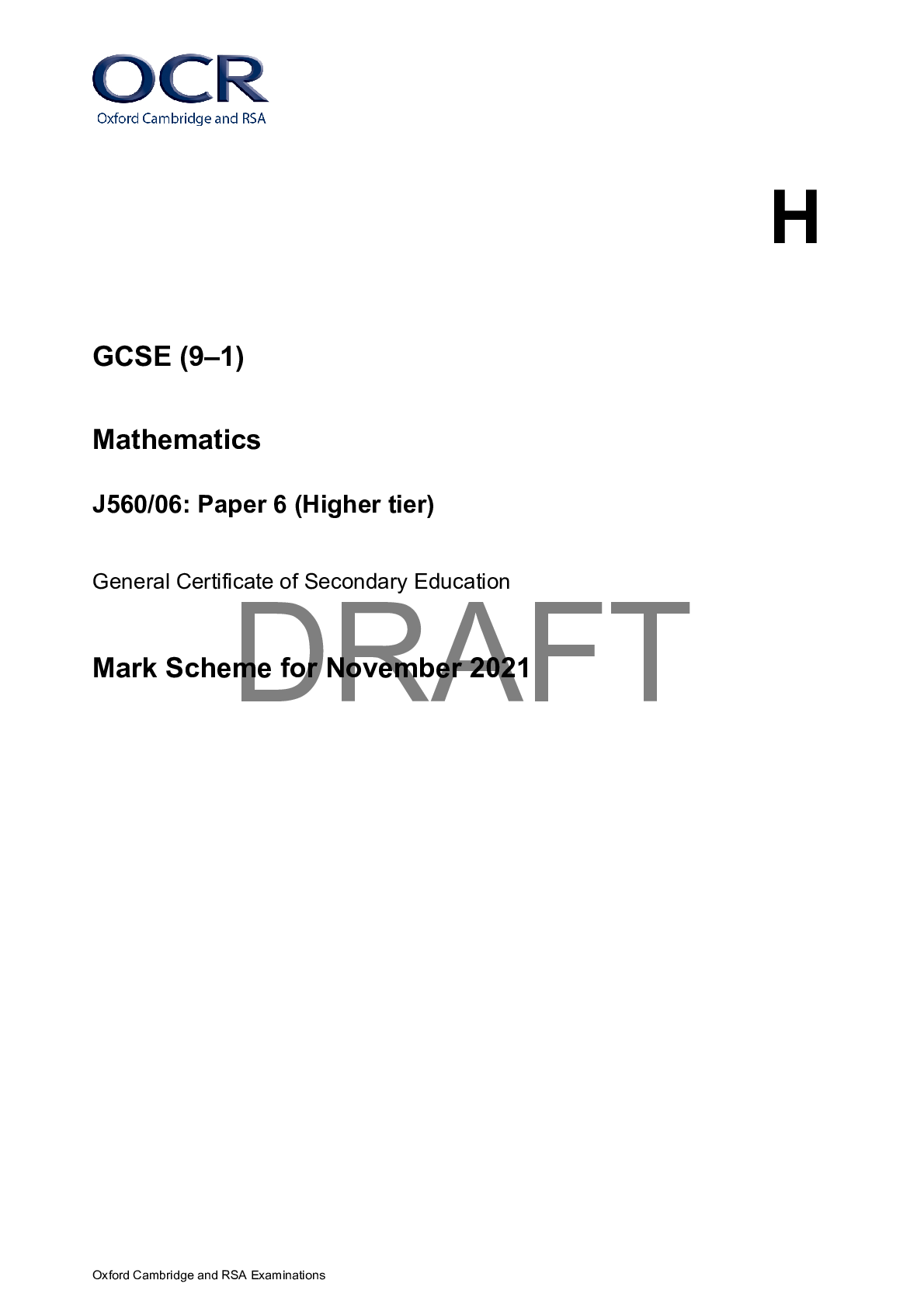

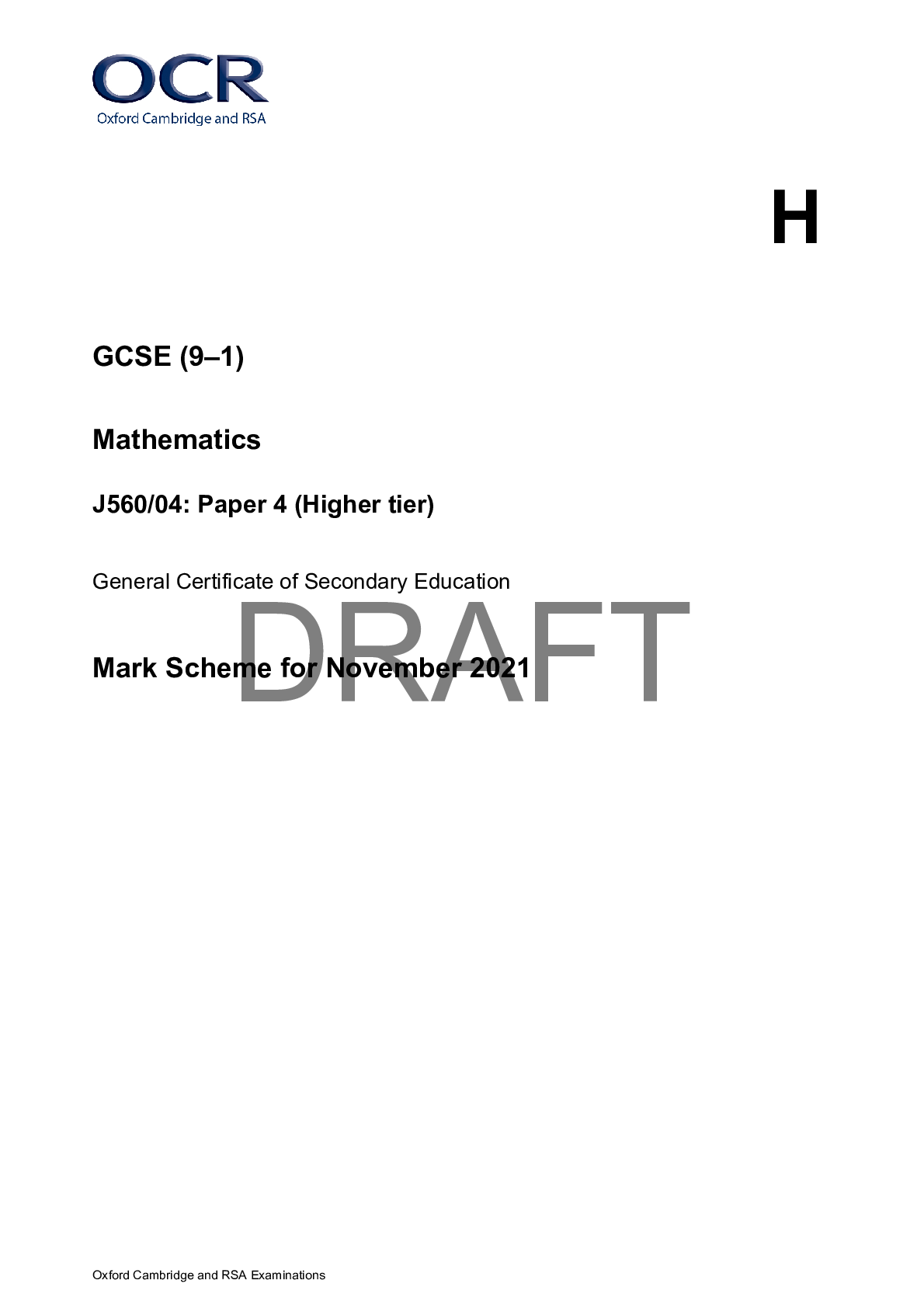
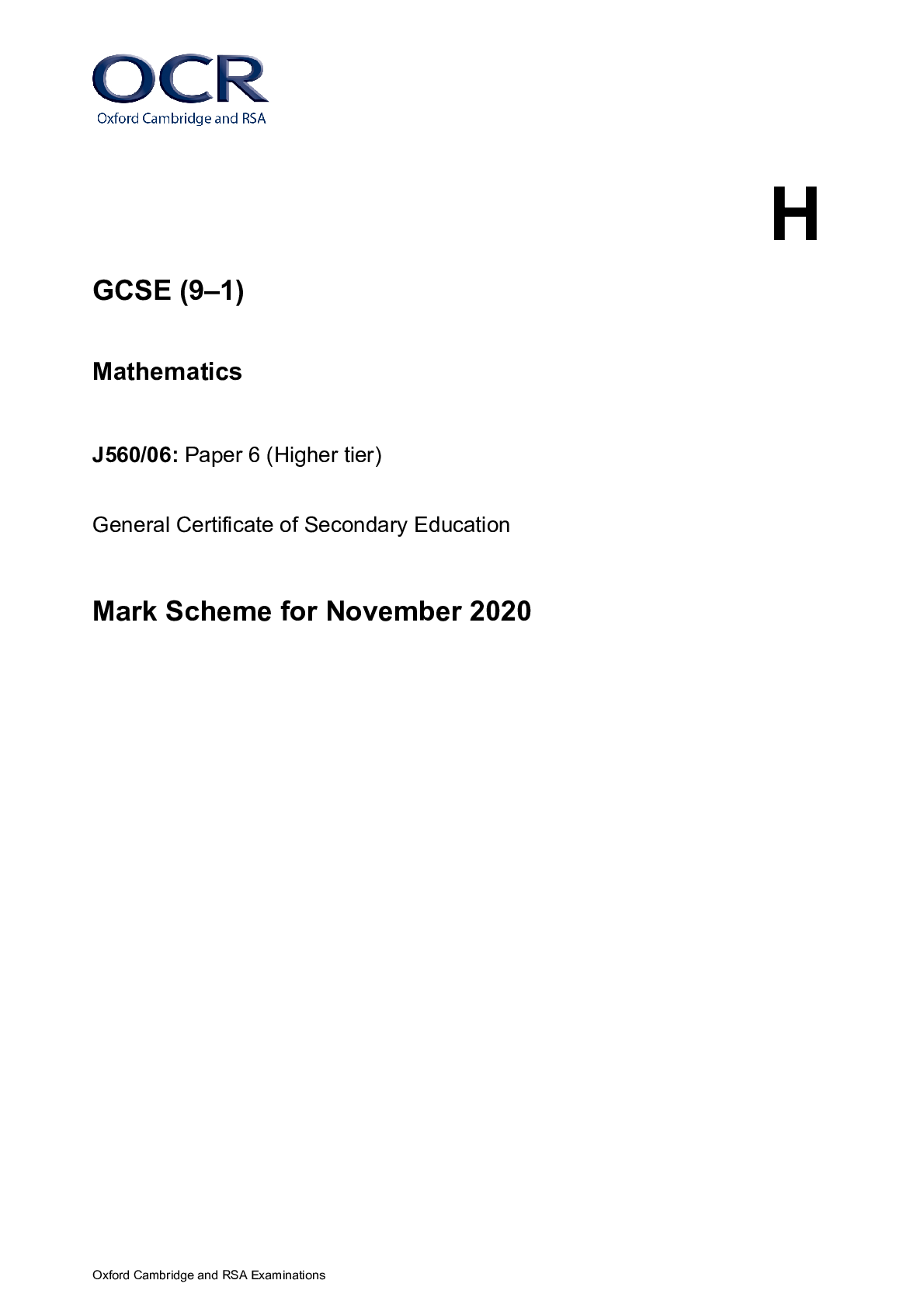
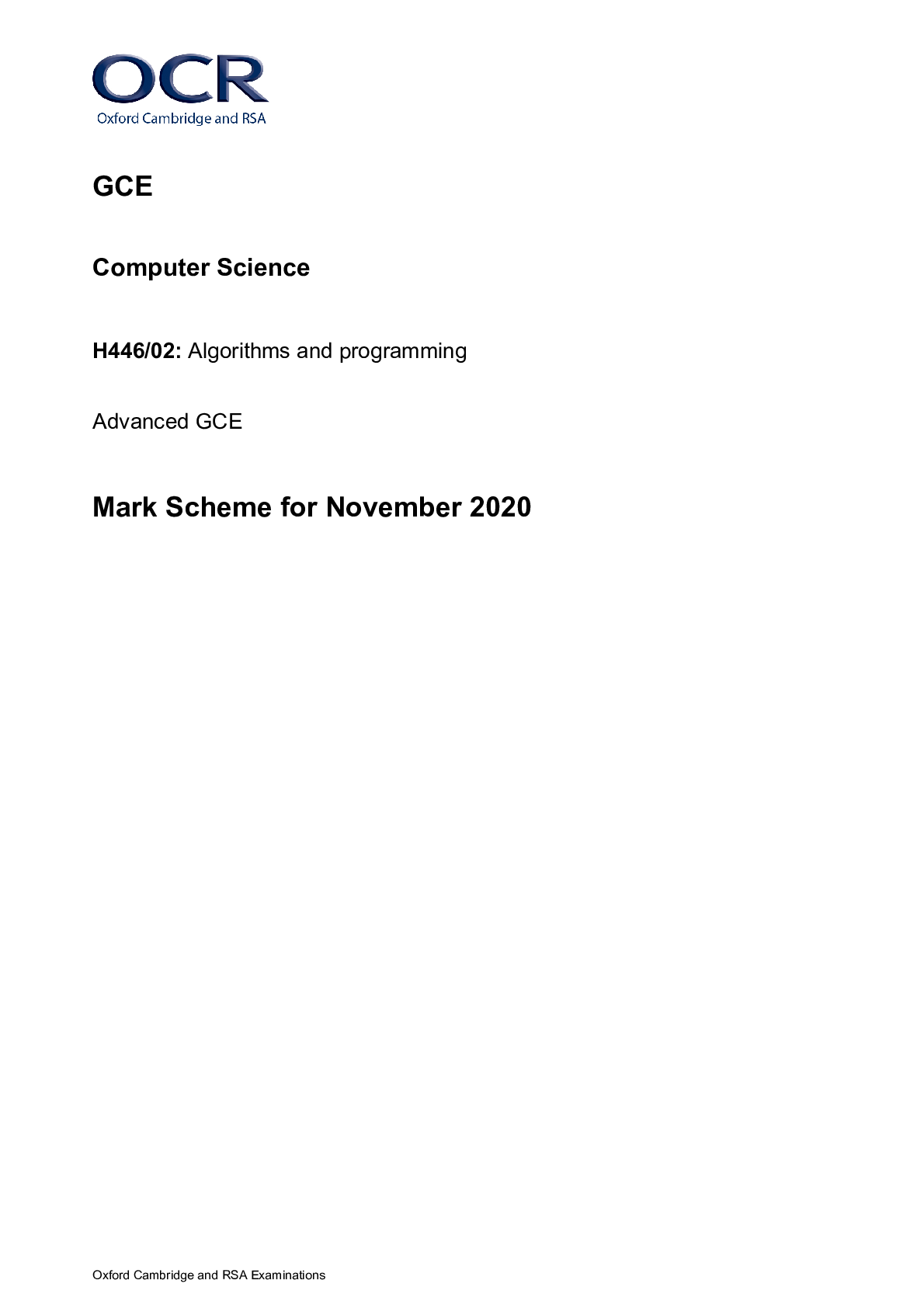
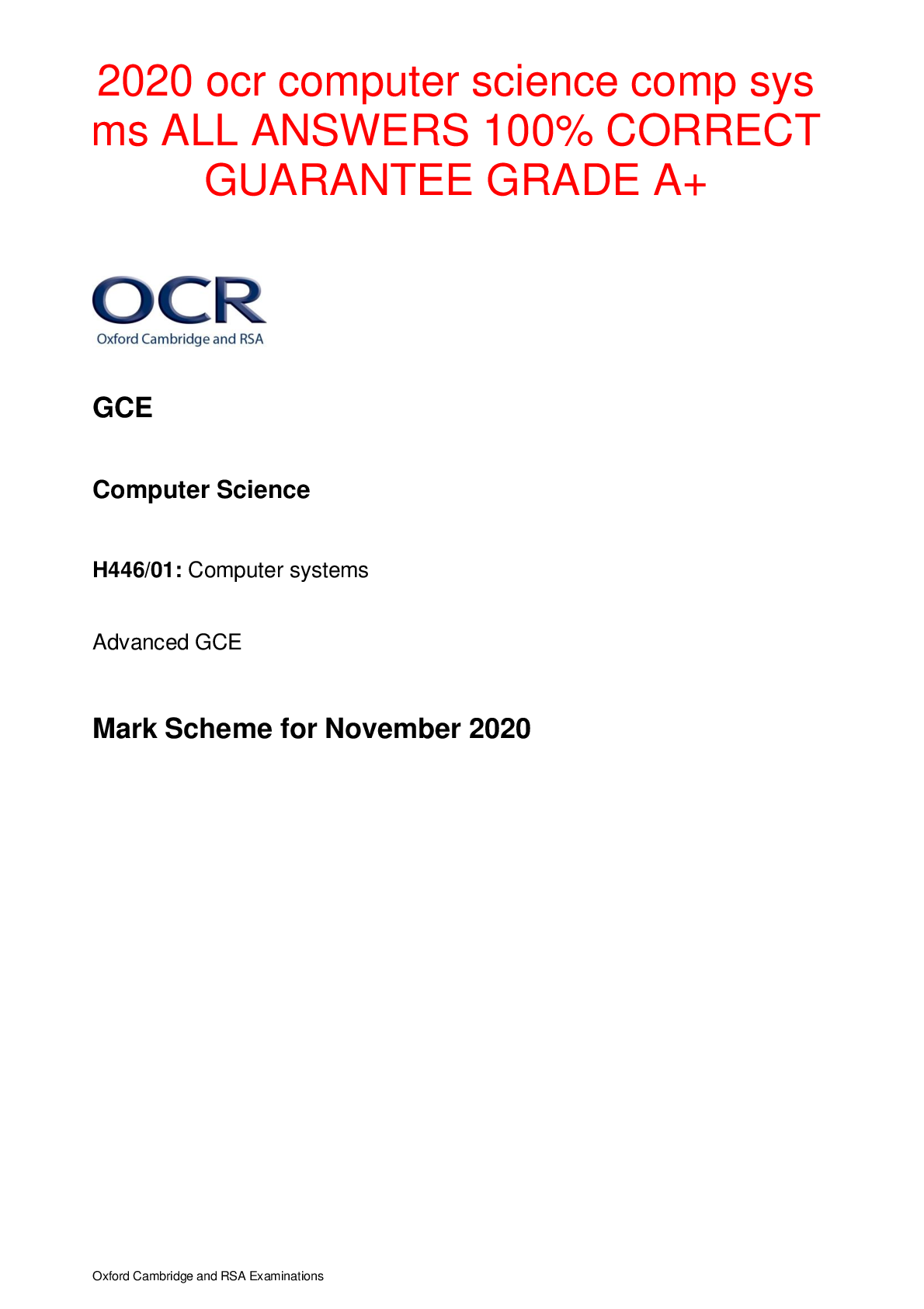

.png)
